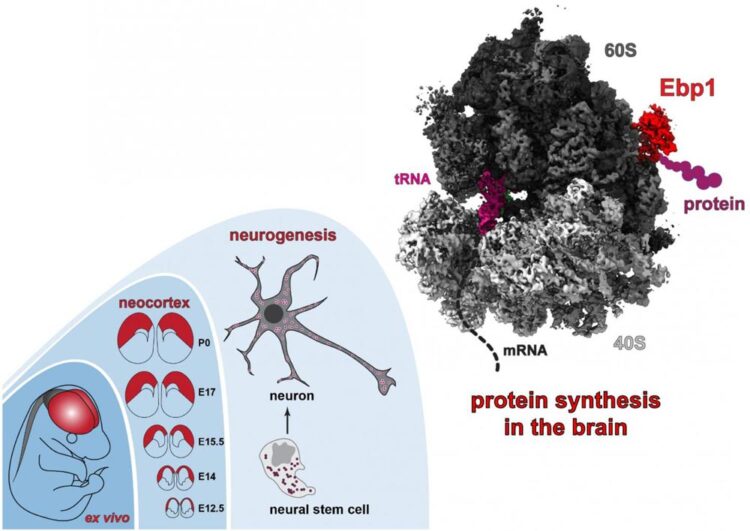The brain’s protein factories at work

A snapshot of protein synthesis in action inside the developing brain.
Image: M.L. Kraushar/Charité
Detailed structure of ribosomes in nerve cells revealed.
Protein synthesis is a finely tuned process in the cell by macromolecules known as ribosomes. Which regulators are responsible for controlling protein synthesis in the brain, and how do they exert their control on the ribosome? To address this question, a team of researchers from Charité – Universitätsmedizin Berlin studied the structure of the brain’s ribosomal complexes in great detail. The team was able to identify a new factor which is also involved in controlling brain development. Details of this research have been published in Molecular Cell*.
Proteostasis refers to maintaining a delicate balance of protein levels in the cell, which is of particularly crucial importance to neurons. Abnormal protein production is a characteristic feature of many brain disorders. High precision protein production is of immense importance during the early development of a complex part of the cerebral cortex known as the neocortex. It is particularly important in the production of membrane proteins, which play an important role in cell-to-cell sites of synaptic contact between nerve cells. As the cell’s ‘molecular protein factories’, ribosomes are at the heart of the regulatory processes involved in proteostasis. A range of molecules can influence ribosome function, and are responsible for controlling the production of specific proteins in different tissues and at different developmental stages. The way in which these various factors interact with the ribosome during development remains widely unknown. However, a group of Charité researchers has successfully observed protein production by ribosomes in the developing brain.
“It is the first time the ribosomal complex has been visualized in action inside the brain at near atomic-level resolution,” says Prof. Dr. Christian Spahn, Director of Charité’s Institute of Medical Physics and Biophysics. “While the structure of the ribosomal complex has been mapped in other tissues and organisms, our approach enabled us to identify Ebp1 as the new key factor responsible for controlling both ribosome function and the synthesis of specific proteins during brain development.” The interaction between the regulatory protein Ebp1 (short for ErbB3 binding protein 1) and the ribosome takes place at the ribosome’s exit tunnel, through which the newly formed protein chain emerges from the ribosome. Through this interaction, Ebp1 influences the production of membrane proteins that play an important role in neuronal interactions, thus maintaining neuronal proteostasis.
As part of a multidisciplinary project linking aspects of structural biology and neuroscience, the researchers used cryo-electron microscopy (cryo-EM) as their main investigative tool, combining it with mass spectrometry, RNA sequencing and genetic techniques. The cryo-EM imaging technique enables scientists to determine protein structures – particularly larger complexes comprising multiple molecules – at extremely low temperatures and near-physiological conditions. The study’s first author, Dr. Dr. Matthew L. Kraushar (a neuroscientist at the Max Planck Institute for Molecular Genetics (MPIMG) in Berlin and previously a member of Prof. Spahn’s laboratory), explains: “We could therefore visualize the molecular architecture of the ribosome at high resolution, as it would be found inside brain cells. We were able to capture snapshots of the ribosome in action.”
“Protein production in various types of brain cells is subject to finely tuned control mechanisms. Small changes can lead to big consequences, such as neurodegenerative diseases or disrupted development. Our findings on the role of ribosomes during normal brain development will help us to better understand pathological changes affecting the brain,” says Prof. Spahn. As a next step, the researchers are conducting a large-scale study to understand the way ribosomes translate messages from the genetic code (mRNA) into numerous essential proteins throughout brain development.
###
*Kraushar ML et al. Protein synthesis in the developing neocortex at near-atomic resolution reveals Ebp1-mediated neuronal proteostasis at the 60S tunnel exit. Mol Cell. 2020 Dec 22. doi: 10.1016/j.molcel.2020.11.037
All latest news from the category: Life Sciences and Chemistry
Articles and reports from the Life Sciences and chemistry area deal with applied and basic research into modern biology, chemistry and human medicine.
Valuable information can be found on a range of life sciences fields including bacteriology, biochemistry, bionics, bioinformatics, biophysics, biotechnology, genetics, geobotany, human biology, marine biology, microbiology, molecular biology, cellular biology, zoology, bioinorganic chemistry, microchemistry and environmental chemistry.
Newest articles

Bringing bio-inspired robots to life
Nebraska researcher Eric Markvicka gets NSF CAREER Award to pursue manufacture of novel materials for soft robotics and stretchable electronics. Engineers are increasingly eager to develop robots that mimic the…

Bella moths use poison to attract mates
Scientists are closer to finding out how. Pyrrolizidine alkaloids are as bitter and toxic as they are hard to pronounce. They’re produced by several different types of plants and are…

AI tool creates ‘synthetic’ images of cells
…for enhanced microscopy analysis. Observing individual cells through microscopes can reveal a range of important cell biological phenomena that frequently play a role in human diseases, but the process of…





















